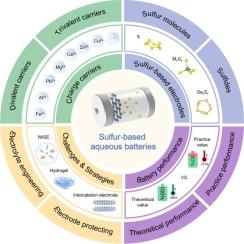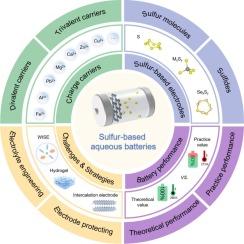含水硫电池:从电极电化学设计到多价电荷载体策略
IF 23.5
1区 化学
Q1 CHEMISTRY, INORGANIC & NUCLEAR
引用次数: 0
摘要
硫是一种环保且低成本的高能量密度电池材料。除了在非水电池中广泛报道的硫电化学外,水硫电池因其高理论容量和快速氧化还原动力学而成为最有前途的储能系统之一。本文综述了近几十年来多价载流子硫水电池的研究进展,重点介绍了多价载流子硫水电池的电极、载流子和电解质,以及相应的挑战、策略和应用。简要地说,我们首先描述了硫电极的前沿创新,从分类到挑战和当前可用的策略。随后,我们特别强调了电荷载流子的选择,包括各种报道的阳离子,如Zn2+, Cu2+, Fe2+, Pb2+, Mn2+, Ca2+, Mg2+, Al3+, Co2+, Ni2+, Cd2+和In3+。考虑到活性金属在水溶液中的高反应性,总结了三种电极保护策略:金属氧化物电极、盐包水电解质和水凝胶电解质。最后,系统比较了不同体系的实际电化学性能及其热力学数据,阐述了在特定应用场景下的可行性。本工作旨在促进含水硫电池的发展,并为其更好的设计提供指导。本文章由计算机程序翻译,如有差异,请以英文原文为准。


Aqueous sulfur batteries: From electrode electrochemistry design to multivalent charge carrier strategy
Sulfur is an eco-friendly and low-cost material for high energy density batteries. Except for the widely reported sulfur electrochemistry in non-aqueous batteries, aqueous sulfur batteries have emerged as one of the most promising energy storage systems due to their high theoretical capacity and rapid redox kinetics. This work summarizes the research progress of aqueous sulfur batteries with multivalent charge carriers in the last decades, focusing on their electrodes, charge carriers and electrolytes with corresponding challenges, strategies, and applications. Briefly, we first delineate the forefront innovations of sulfur electrodes, spanning from the classification to their challenges and currently available strategies. Subsequently, we place special emphasis on the selection of charge carriers, including various reported cations such as Zn2+, Cu2+, Fe2+, Pb2+, Mn2+, Ca2+, Mg2+, Al3+, Co2+, Ni2+, Cd2+, and In3+. Considering the high reactivity of active metals in aqueous electrolytes, three strategies for electrode protection are summarized, including the employment of metal oxide electrodes, water-in-salt electrolytes, and hydrogel electrolytes. Finally, the practical electrochemical properties of different systems and their thermodynamics data are systematically compared to elaborate the feasibilities in particular application scenarios. This work aims to promote the development of aqueous sulfur batteries and provide guidance for their better design.
求助全文
通过发布文献求助,成功后即可免费获取论文全文。
去求助
来源期刊

Coordination Chemistry Reviews
化学-无机化学与核化学
CiteScore
34.30
自引率
5.30%
发文量
457
审稿时长
54 days
期刊介绍:
Coordination Chemistry Reviews offers rapid publication of review articles on current and significant topics in coordination chemistry, encompassing organometallic, supramolecular, theoretical, and bioinorganic chemistry. It also covers catalysis, materials chemistry, and metal-organic frameworks from a coordination chemistry perspective. Reviews summarize recent developments or discuss specific techniques, welcoming contributions from both established and emerging researchers.
The journal releases special issues on timely subjects, including those featuring contributions from specific regions or conferences. Occasional full-length book articles are also featured. Additionally, special volumes cover annual reviews of main group chemistry, transition metal group chemistry, and organometallic chemistry. These comprehensive reviews are vital resources for those engaged in coordination chemistry, further establishing Coordination Chemistry Reviews as a hub for insightful surveys in inorganic and physical inorganic chemistry.
 求助内容:
求助内容: 应助结果提醒方式:
应助结果提醒方式:


